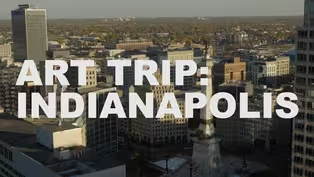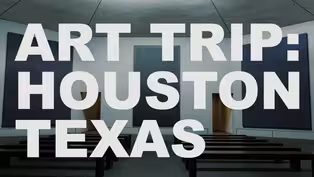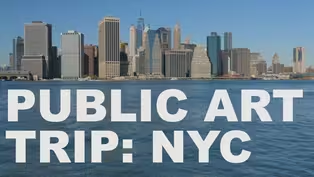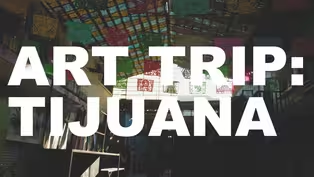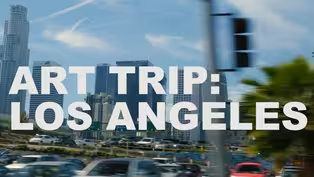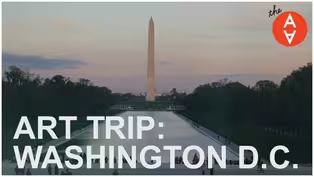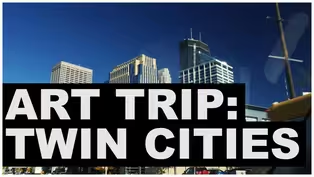
Art Trip: PST: LA/LA
Season 4 Episode 20 | 20m 17sVideo has Closed Captions
We take a trip to LA and look at the Getty-funded initiative Pacific Standard Time: LA/LA.
Latin American and Latinx Art is celebrated across Southern California with the Getty-funded initiative Pacific Standard Time: LA/LA. Catch a glimpse of as much of the art, artists, experiences, and tacos as we could pack into three days.
Problems playing video? | Closed Captioning Feedback
Problems playing video? | Closed Captioning Feedback

Art Trip: PST: LA/LA
Season 4 Episode 20 | 20m 17sVideo has Closed Captions
Latin American and Latinx Art is celebrated across Southern California with the Getty-funded initiative Pacific Standard Time: LA/LA. Catch a glimpse of as much of the art, artists, experiences, and tacos as we could pack into three days.
Problems playing video? | Closed Captioning Feedback
How to Watch The Art Assignment
The Art Assignment is available to stream on pbs.org and the free PBS App, available on iPhone, Apple TV, Android TV, Android smartphones, Amazon Fire TV, Amazon Fire Tablet, Roku, Samsung Smart TV, and Vizio.
Providing Support for PBS.org
Learn Moreabout PBS online sponsorshipMore from This Collection
Exploring cities' many fantastic art offerings.
Video has Closed Captions
We figured it was time to come back home and try being tourists in our own town. (12m 36s)
Video has Closed Captions
We take an art pilgrimage to Houston, Texas, and visit the likes of the Rothko Chapel, Jam (14m 4s)
Video has Closed Captions
For our second international art trip, we travel to London during Frieze Art Fair. (12m 31s)
Public Art Trip: New York City
Video has Closed Captions
New York City offers way too many art-viewing opportunities for us to cover in a single ep (7m 39s)
Video has Closed Captions
This week we travel to Tijuana to meet with Ghana Think Tank and Torolab. (13m 8s)
Video has Closed Captions
In which we explore sunny Los Angeles and take in its enormous range of art offerings. (8m 52s)
Video has Closed Captions
We explore Washington DC's vast collection of landmarks, museums, and galleries. (11m 8s)
Video has Closed Captions
In which we explore a few of Minnesota's many fantastic art offerings. (5m 22s)
Providing Support for PBS.org
Learn Moreabout PBS online sponsorshipWe have previously visited Los Angeles interviewing artists walking in a geodesic dome watching our favorite art museums eating ramen stuck in traffic.
But now we have returned to a specific goal in mind.
Not to see the city of Los Angeles we already know, but to see the city of Los Angeles that we should know, that which has been hiding at a glance which has not even been hiding and that, in fact, recent efforts have made it more difficult to ignore.
We come directly from the airport to the Museum of Craft and Folk Art (Craft and Folk Art Museum) whose facade is the site of a project by the artist Shrine residing in Los Angeles.
Inside, it is presenting an exhibition on the US border.
UU.- Mexico and then we see the plaster model sculpture cement floors 5 Armando Muñoz García he built in his neighborhood in Tijuana, where he also lived.
He built the figure in 1989 to commemorate the centenary of the city.
Her little finger raised points where you can find it on a map of Mexico.
The exhibition includes the work of artists from many disciplines, as the drum revolver to store pens industrial designer Jorge Diego Etienne, with the name of Choose Your Bullets ( "Choose your bullets").
Collaborative painting made of soil and vegetation in the border region of GT Pellizzi and Ray Smith.
Viviana structure walls made of tequila bottles pattern recycled.
And the series of jewelry Haydee Alonso INTER-ACTING, it requires two people to activate and it relates to the border as a similar connection point between two cities.
Upstairs there are two floors of works that explore the border as a physical reality, a subject and as a place for production and possibilities.
It is Cartonlandia of Ana Serrano, miniature imitating the labyrinthine villages on the hilltops found in many cities, including Tijuana and Los Angeles.
Is the deconstructed serape Adrian Esparza, whose threads have unraveled carefully and are fixed to the wall in a geometric design.
There is also the Borderwall as Architecture ( "Border Wall as architecture") of Ronald Rael and Virginia San Fratello project; Alternative proposals for the design and entertainment approaches border walls, presented through a series of prints and patterns.
A wall swing, a xylophone wall.
They have also made a game of table border wall.
This exhibit is only a space of an initiative to expand directed by (Getty Foundation) Getty Foundation called Pacific Standard Time: LA / LA it is exploring Latin American and latinx art in dialogue with Los Angeles and much of Southern California.
In this exhibition, the fluidity between geographies, cultures and economies It is shown very clearly.
Especially in the work of Cog " nate Collective, led by Amy Sanchez and Misael Diaz, who were fortunate to have with us to tell us about their work.
The first is called transborder Trajectories or in Spanish: "Transboundary Trajectories" and his work, mmm, which began around 2010 when we were working on a craft market which it is right at the crossing between San Diego and Tijuana Port of Entry in San Ysidro, in a market called: Artisans Market of the line.
There, they sell items that are very attractive and interesting.
But when you're a kid, they tell you never look, because if you do, sellers will come and try to sell that object aggressively, and as you walk so slowly, It will be a very long and uncomfortable exchange.
In "Transborder Trajectories" we try to make a map of flows and movements of these objects, and how these flows and movements talk about the kind of particularities involving these economic, social and cultural exchanges which occur and take place across the border.
And with "The Tele" with Reform Project, we take care to engage in dialogue with people who really did, so try to imagine what it would really mean to create a souvenir of Tijuana as a city.
And that took the form of a television, Tijuana because until recently was, if not yet the world capital of television production.
So there's more televisions manufactured in the city than anywhere else in the world And much of this production takes place in the maquiladoras, which are large factories.
And many of these factories then begin to shape how the city develops, They begin to shape working conditions also within the city and much of the economy of communities throughout the city.
So we decided to think of this souvenir television as an object to speak of such economic conditions, but also the fact that it is precisely through television where many of these images end up seeping to take the form of piggy banks and they are made and sold to tourists.
We said goodbye to Amy and Misael and headed Stews, where Jesus made us think that the tacos could be free.
Actually, they cost about $ 3 each, but they were super delicious and were worth every penny.
Just around the corner is the West Hollywood Park, where we find the work of Jose Davila, Sense of Place, commissioned by the Los Angeles Nomadic Division (Los Angeles Nomadic Division).
The sculpture by the artist located in Guadalajara, made of concrete, six tons It is composed of 40 unique ways, that during nine months will be dismantled and the pieces will be moved to different locations in the city and it will eventually reassembled in May 2018.
Across the street is the Pacific Design Center MOCA, where you can see a display spot Axis World: Queer Networks in Chicano LA, the National Archives organizes gay and lesbian ONE in the libraries of the University of Southern California (USC Libraries).
World begins introducing us to Meza, an artist who made large paintings and curios, He collaborated with many and though it seems crazy, does not have a page on Wikipedia.
The curators have assembled and shared with us a wealth of artwork and ephemera written material pointing a network of queer Chicano artists in the late 1960s to early 1990s.
Including well-known artists such as Asco group, a selection of art postcards Movie not shown; a film that ranges from nonexistent movies, noting the absence of Chicano representation in popular culture.
Many of the artists were affected by the AIDS crisis and several of them died from unrelated causes, It is including Ray Navarro, who got his friend Zoe Leonard did this work for him during the last months of his life.
Blind and deaf due to meningitis caused by AIDS, He gathered photos of the instruments used to scroll with sexually suggestive signs in the style used in hospitals.
Here is a collision of movement civil -Rights of Chicanos, gay liberation, feminism, activism by AIDS And how they are deployed through art, fashion, print media and punk, especially among friends and colleagues here in Los Angeles.
Then we traveled to the top of a hill in Santa Monica to enter another dimension or what is popularly known as the Getty Center, the majestic and complex design of Richard Meier, with travertine cladding, which it is still home not one, but four exhibitions for Pacific Standard Time: LA / LA.
Each is impressive, but we can not show them all Why do not we focus objectively better in my favorite?
Making Concrete Art is a window into strategies and materials artists associated with the movement of concrete art that evolved in Argentina and Brazil, from the mid 1940s to the early 1960s.
The artists whose work come here, consciously they rejected ubiquitous rectangular shape, considering it as a division between art and everything around it and they created irregularly cut panels and individual planes that sit just outside the wall.
They also experimented with industrial and commercial paints and materials and techniques, trying to minimize the presence of his own hand and create something as geometric and precise to form their own concrete reality.
And we could not stop raising the Getty and not take a walk through the center that designed Robert Irwin, whose path leads us forward and backward, through roundabouts fantastic bougainvillea, to reach a well with a floating maze of azaleas.
Nor they can leave without appreciate the view, We started our second day at the Central Library downtown, a splendid art deco building 1927 whose rotunda had it to ourselves for a few minutes before it opened.
Lots to see, Zodiac Chandelier (candelabra zodiac) original bronze, decorative motifs painted on concrete walls and a mural cycle in the upper walls by Dean Cornwell, depicting scenes from the history of California.
But the murals of the 1930s, showing a history of colonialism largely unilateral measure, shaded white, pales literally and figuratively with a new installation of artistic group of Tlacolulokos It is part of an exhibition and a program celebrating the Zapotec language, the most widely spoken indigenous language in Oaxaca state in southern Mexico, where are the artists.
There is a large population of Oaxaca in Los Angeles and a great cultural exchange between the two places, It presented to us by the characters who inhabit this vivid installation.
It is a contemporary story that shows the complexity of cultural identity, told by artists in tune with unforeseen contingencies.
It is scheduled to be clearing early next year, but really should stay.
From there it was a short trip to Los Angeles Plaza Park, where the city was founded and served as the center of the city during the Spanish, then Mexican government and the US.
UU.
They were riding community altars for Day of the Dead festival celebrated by the Merchants Association Olvera Street and El Pueblo Historic Monument.
Nearby is the Plaza of Culture and Arts of Los Angeles, a center that celebrates the enduring influence and evolution of Mexican culture and Mexican-American in the region.
During this whole year, make programs and exhibitions, one of which is the current sample, in association with Pacific Standard Time, Murals Rebels!
LA Chicana / o Murals Under Siege, done in collaboration with the Historical Society of California (California Historical Society) Rigorously investigated, the exhibition shares the sketches between 1970 and 1990 they have been challenged, questioned, censored or destroyed.
Here you can see the Polaroid sister Barbara Carrasco who is the main character in his 1981 mural, and learn how commissioned and approved the Community Redevelopment Agency (Community Redevelopment Agency) but it was canceled before it could be on display because, along with positive images, It included representations of negative incidents experienced by communities of color.
You can, and I did spend a lot of time examining each case study and gain a renewed appreciation for the thoroughness and commitment behind each of these murals and a renewed disgust at the way in which many of them are disrespected and destroyed.
On a bright note, the mural Carrasco was recently installed for a while in Los Angeles Union Station and hopefully you will find a more permanent public home as soon as possible.
We restocked in Sonoratown a small place that serves tacos northern Mexico style with fresh flour tortillas.
I could have eaten twelve, but that would have affected our ability to continue to our next stop, the new Institute of Contemporary Art, Los Angeles.
Here we enjoy the fantastic exhibition of Martin Ramirez, the first solo presentation of his work in Southern California, despite being an acclaimed self-taught artist and he has lived in the state since the 1920s until his death in 1962.
Ramirez, born in Mexico, was diagnosed with schizophrenia and he spent most of his life in state hospitals, where he produced a lot of work.
drawings and collages made of found papers, pencils, crayons and matches, grouped to demonstrate the types of ways to make brands and patterns and iconography visited again and again through his work.
Store at the Institute of Contemporary Art (Institute of Contemporary Art, ICA) Los Angeles, Christina Kim and Dosa Mercantile have created a commercial space and immersion absolutely beautiful where the environment, clothing and products are inspired by the palette of colors and textures work Ramirez Then we went into a kind of immersive experience completely different at the Geffen Contemporary at MOCA.
To be a reference, this store has worn well, and so for previous samples.
But for installation by Argentine artist Adrián Villar Rojas, the Theater of the disappearance, it has become darker and has transformed and takes a while for your eyes and your camera suit.
In this landscape that created, I'm not sure if I'm in the past, the future or in some sort of alternate present, however, I move around rocks and columns made of layers of concrete and synthetic amber and I find refrigerated compartments strongly illuminated.
Within these you can see still life with a very careful composition of organic and inorganic things, slowly rotting flesh and vases in one, and fish internal organs, branches and shells in another.
These samples are disgusting and fascinating at the same time, blurring the distinction between living and nonliving, the man-made and natural.
What is the difference between an old tennis shoe and a giant shell crab or a human skull?
We're just a set of material that decomposes slowly and all roads lead only to the grave.
So, as we mentioned, our trip coincided with celebrations of the Day of the Dead and events around the city.
Self Help Graphics and Art has been organizing the public ritual of the Day of the Dead in East Los Angeles since 1972 and its new exhibit provides three "offerings" newly appointed, representing the past, present and future and it chronicles the evolution of the commemoration of Self Help through the decades by prints, objects and writings.
Each year, Self Help produces a limited edition commemorative print, which can be seen here in the sample, including this 2014 Luis Genaro Garcia.
Luis is a talented artist and a generous educator, who decided to locate and meet with him in South Park in south central Los Angeles, very close to where he grew up.
It is an art teacher at his alma mater, Thomas Jefferson High School, and he is now creating an offering for the Festival Day of the Dead, sponsored by the Council of District 9, students who later will be contributing a shoebox altar they have done.
and traditions and stories with which you are participating.
I think there is a misconception that the Day of the Dead is related to the worship of death, Which is not true.
It is really a historical tradition which it has developed from two cultures to honor the dead.
Because MMM, you know, it is through knowledge of our ancestors we maintain our own history, right?
And we know where we come from and who we are now When we are aware of our past.
You know, although people are no longer with us, that does not mean we can not celebrate and appreciate their lives, right?
You know, we live with the idea that the Day of the Dead, which is on November 2, the spirits return one day to be among us in the world of the living.
So we must seize this day to place them altars.
They need to be with the favorite things they like to do, mmm, and, and really it is a time for the family to rejoice in life and is a time to celebrate, right?
It is not, it is not really a time for mourning.
We experience a duel when people leave, but we have to heal ourselves celebrating their lives.
Day 3: The next morning, before they opened the museum, we took a walk around Echo Park and observe all events and samples of Pacific Standard Time: LA / LA we were not going to have time to see.
There are offerings in Pasadena, Pomona, in Palm Springs, in Torrance and San Diego not to mention all programs and associated public workshops and resources for educators.
This is a city where, due to traffic, it is difficult to get more than a couple of places in one day.
But I realized that that's exactly what this initiative has to be so widespread.
You not have to go to all places, but with this method of dispersing the more likely that one of these events reaches you.
I will heavily reduce our final day because there is no way I can do justice to the scope of scholarship, experience, skills and accomplishments that we witnessed We pass the new public work of Venezuelan artist Carlos Cruz-Diez, Crosswalk painted designs strongly at the intersection of Grand Avenue and West 2nd Street.
At MOCA Grand Avenue, just down the street, We delight us with wit and tactile pleasure of the various works Brazilian artist Anna Maria Maiolino in his first major retrospective in museums in the US.
UU.
Little Damage we stopped for soft ice cream and one of them was gray, but he tasted like pumpkin pie and another had eyes.
We got back to the west side and spent hours in the reference display Hammer Museum (Hammer Museum) Radical Women: Latin American Art, 1960-1985 (Radical Women: Latin American art).
I tore down the volume and depth of what she shared about the artists whose work has been acclaimed unheralded and little long.
We gave back quickly to the center and stopped in Self Help to give out their evening community art workshops.
Preparations for the night Offering were on track, which starts observing the Day of the Dead center.
Local artists, community members and volunteers They gather here to make paper flowers, paint masks and build and paint representations of papier-mâché for the event that night and the festival still ongoing.
Self Help Graphics and Art copresenta this observation in the center with Grand Park where we ended our day.
Here we see the exceptional result of these afternoon workshops, summarized in this impressive offering, along with many others made by individuals and community groups, Honoring and evoking the memory of those who are no longer.
The event also featured a ceremonial invocation that led the local indigenous community, along with traditional dances and prayers, and later there were activities carried out by poets and musicians of Los Angeles residents.
It seems appropriate that we end our tour with an event that is not at all associated with Pacific Standard Time.
What we are experiencing here every year happens.
Places and artists can change, but what we are witnessing is a tradition that has been and will remain an integral part of the culture of Los Angeles.
I guess the difference is we're here.
Pacific Standard Time did not produce this event, but he brought me here and he encouraged me to follow a route to experiences that I would have probably lost.
Because Pacific Standard Time: LA / LA does not really change anything.
It is highlighting artists, movements, stories and traditions they were already present, many of which are already recognized and respected at least in other places or at other times.
But Latin American art and latinx have been ignored here largely for much of the population and many of the establishments currently being host exhibitions and events.
About 40% of the population of Los Angeles County is latinx and it is undeniable that the economy and the culture here it is quite informed by the exchange between the US.
UU.
and Latin America.
It would be absurd if cultural institutions do not reflect this and are not reflected in this.
But there is no guarantee that this care persist.
And it really is impossible to measure the impact of such an initiative.
Perhaps some of these places offer wall texts in Spanish for each display in Future a rational decision, since about 40% of the population speaks Spanish.
Perhaps, he is having seen their culture represented in such a remarkable way, You are more likely to tell their own stories and present and promote their work.
Perhaps they are more willing to seek Latin American art and art latinx when they go on sale.
Or maybe they will write an article about someone who saw represented here.
Or create a page on Wikipedia for World Meza.
Perhaps they think about the voices and stories that are not represented in their city.
And maybe they will do something about it.


- Science and Nature

A documentary series capturing the resilient work of female land stewards across the United States.




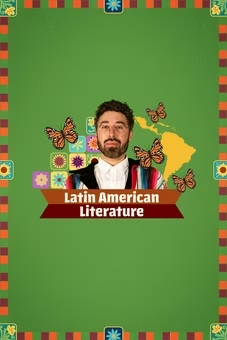







Support for PBS provided by:

